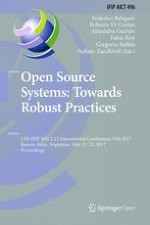1 Introduction
2 Previous Work
2.1 Policies and Practices
3 Research Approach
-
RQ1: How can a software process be organized to allow a hybrid OSS collaboration model?
-
RQ2: What factors can be used to affect openness of the collaboration model?
4 Case Companies
5 Findings
Qt | Vaadin | Sailfish | ||
|---|---|---|---|---|
A | Who can contribute to software code? | 2 | 2 | 1 |
B | Who can test code contributions? | 2 | 2 | 1 |
C | Who can accept code contributions? | 2 | 0 | 1 |
D | Who can verify defect reports? | 2 | 1 | 1 |
E | Who can impact prioritization of work requests | 2 | 2 | 1 |
F | Who knows about the integration process of code contributions? | 2 | 2 | 1 |
G | Who knows what is on the product roadmap? | 1 | 1 | 0 |
H | Who knows timing and content of releases? | 1 | 1 | 0 |
I | Who knows priorities of work issues? | 2 | 0 | 0 |
